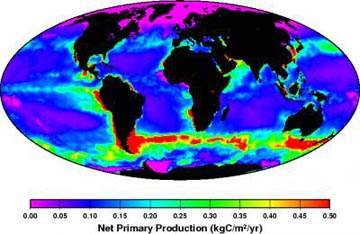Phytoplankton generate about five times as much energy as humans finds study
Phytoplankton generate about five times as much energy as humans finds study
Microorganisms also affect climate
mongabay.com
October 13, 2006
A new study estimates that oceanic phytoplankton generate about five times the annual total energy consumption of humans.
Florida State University Professor William Dewar calculated the amount of amount of chemical power stored annually by phytoplankton at 63 terawatts. For comparison, in 2001 all humanity consumed 13.5 terawatts of power.
 The global distribution of phytoplankton power generation as measured by satellite. Credit: Courtesy of William Dewar, Florida State University
|
The study further found that the marine biosphere — anchored by phytoplankton but including everything from giant squid to the blue whale — puts about one percent of its chemical power in mechanical energy, which has the effect of mixing the world’s oceans, thereby affecting climate.
“By interpreting existing data in a different way, we have predicted theoretically that the amount of mixing caused by ocean swimmers is comparable to the deep ocean mixing caused by the wind blowing on the ocean surface and the effects of the tides,” Dewar said.
“Biosphere mixing appears to provide about one third the power required to bring the deep, cold waters of the world ocean to the surface, which in turn completes the ocean’s conveyor belt circulation critical to the global climate system,” wrote Libby Fairhurst, a writer who interviewed Dewar.
Dewar and his colleagues said that over-fishing and other human-caused damage to the marine biosphere could have a “measurable impact on the total biomixing occurring in the world’s oceans.”
Marine biosphere disruption could be worsening due to higher sea temperatures and increasing amounts of dissolved carbon dioxide. A study published released earlier this year showed that the Pacific Ocean is getting warmer and more acidic, while the amount of oxygen is decreasing, due to increased absorption of atmospheric carbon dioxide. Scientists estimate that the oceans have soaked up about half–118 million tons of atmospheric carbon dioxide–of all fossil fuel emissions over the past 200 years, absorption which has made the world’s oceans significantly more acidic, leaving less carbonate for marine organisms to form protective shells. In late 2005 a team of scientists writing in Nature warned that by 2100, the amount of carbonate available for marine organisms could drop by 60%, while in surface ocean waters, where acidification starts before spreading to the deep sea, there may be too little carbonate for organisms to form shells as soon as 2050. The projections are significant because some marine microorganisms play a role in climate regulation. For example, a Woods Hole Oceanographic Institution study published in July found that Salps, transparent jellyfish-like creatures, play a small role in countering climate change by preventing ocean carbon from re-entering the atmosphere.
This article used quotes and information from a Florida State University news release and previous mongabay.com articles.







